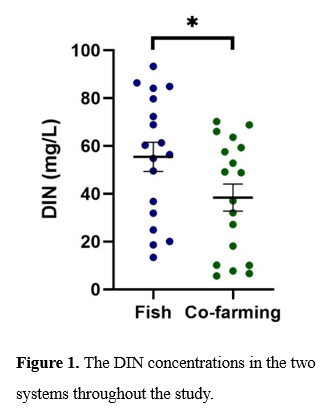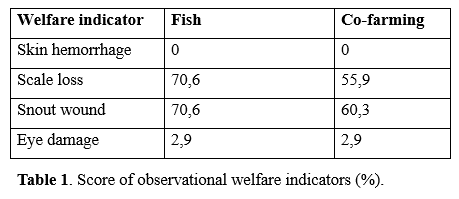EFFECTS OF CO-FARMING RAINBOW TROUT Oncorhynchus mykiss AND DUCKWEED Lemna minor ON NITROGEN CYCLING AND FISH HEALTH IN RAS
Background
Co-farming within integrated multitrophic aquaculture (IMTA) can improve the nutrient retention and utilization in aquaculture. In IMTA systems, the nutrients from fed species are consumed by extractive species, thereby converting waste products into new biomass. Duckweed (Lemna minor) is a freshwater plant that has been suggested as an efficient nitrogen and phosphate remediator in aquaponics and Recirculating Aquaculture Systems (RAS) . The high growth rate in combination with an ability to assimilate nitrogen from both ammonia, nitrite, and nitrate , makes it a suitable for co-farming with fish. In warm-water RAS, duckweed has been found to reduce ammonia concentrations in the water and improve fish growth. There is, however, a lack of studies on the potential effects of using duckweed as an extractive species in cold-water RAS.
On the Swedish west coast , RAS are expected to be the main system for future aquaculture expansion due to strict environmental laws in combination with coastal waters in risk of eutrophication. To achieve a high degree of water recirculation in RAS, there is a need for efficient methods to utilize the dissolved nitrogenous waste. Co-farming with duckweed is a potential solution to extract the nitrogens and thereby improve system water quality. As the main farmed fish species in Sweden is rainbow trout (Oncorhynchus mykiss) in cold freshwater, duck weed can be added on as an extractive species without altering the preferred water parameters. The research question in this study was to evaluate the effects on water quality and system nitrogen as well as growth, health, and welfare of rainbow trout when co-farmed with duckweed. To assess this question, we performed a 6-week co-farming trial in two identical RAS systems except that one system held only fish and the other held both fish and duckweed that were farmed in a separate rack system connected in parallel to the RAS.
Material and methods
Two identical freshwater RAS (425 L ) were set-up in a temperature control room (water temperature 12.2 °C), each containing four aquaria (93.2 L) . The RAS loop contained two mechanical filters, a pump sump with a biofilter of bio balls, a UV-filter, and air bubbling . At the experimental start 72 rainbow trout, with an average mass of 47.5 ± 0.86 g (± SEM), were added to each system . One of the RAS also had a rack with four duckweed tanks (23 L) attached in the loop, with LED lights above each tank. At the experimental start, 186 g duckweed was distributed between the holding tanks . The experiment lasted for 6 weeks.
Water samples were taken three times per week to analyse for dissolved ammonium (NH4+), nitrite (NO2- ), nitrate (NO3- ), and phosphate (PO42- ). Dissolved inorganic nitrogen (DIN) was calculated as the sum of NH4+, NO2-, and NO3- . The mass of feed given to the fish was registered for each day and system and remaining feed pellets and faeces were collected and separated . The pellets and faeces were dried and weighted and sent for analysis of total nitrogen content. Duckweed was harvested when required, based on their density, and the removed biomass was weighted and sent for analysis of total nitrogen content. Selected observational welfare indicators (OWIs) were recorded for all fish triweekly, and each tank was scored for presence (1) or absence (0) of the following four OWI parameters: skin haemorrhage, scale loss, snout wound, and eye damage.
At the final sampling, fish (n = 12) were euthanized in metomidate (12 mg/L) and killed with a sharp blow to the head. A blood sample was taken from the caudal vei n, centrifuged, and the plasma was stored in -80 °C for subsequent analysis of cortisol and ion concentrations. Samples of skin , proximal intestine, and distal intestine were taken for in vitro analysis of barrier function using the Ussing chamber technique. Liver samples were taken and placed in liquid nitrogen until analysed for two oxidative stress markers: lipid peroxidation (LPO) and glutathione assay.
Results and d iscussion
DIN concentrations in the co-farming system (38.3 ± 5.5 mg/L) were lower than in the system with only fish (55.4 ± 5.9 mg/L; t( 34) = 2.049, p = 0.048 ). This reduction was reflected in lower concentrations of NO3- and NO2- but not NH4+. The dissolved nitrogen was mainly present as NO3- ( 54.45 ± 5.90 mg/L for fish, 37.27 ± 5.49 for co-farming) with less as NO2- (0.59 ± 0.04 mg/L and 0.38 ± 0.04, respectively) and even less as NH4+ (0.37 ± 0.03 mg/L and 0.69 ± 0.07, respectively) . This suggests that the duckweed was an efficient assimilator mainly of NO3- and NO2- in our system . The PO42- concentration tended to be lower, although not statistically significant, in the co-farming system (6.53 ± 1.86 mg/L) than the fish system (6.83 ± 0.80 mg/L).
The pH was higher for the co-farming system (7.24 ± 0.07) than the system with only fish (6.95 ± 0.11 ; t( 34) = -2.183, p = 0.036). Maintaining a high pH in RAS is a challenge as it tends to be reduced by CO2 production of fish and microbes at the same time as the alkalinity is consumed by nitrifying bacteria in the biofilter. The results suggest that c o-farming with duckweed could help counteract these effects.
There were no growth differences of the rainbow trout between the two systems. The welfare indicators scale loss and snout wound, although not statistically significant, tended to be less frequently occurring in the co-farming system.
At the conference, remaining effects on fish health and welfare will be presented, including plasma cortisol and ion concentrations, skin and gut barrier function, and oxidative stress markers in the liver tissue.

